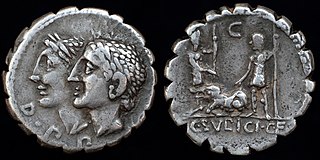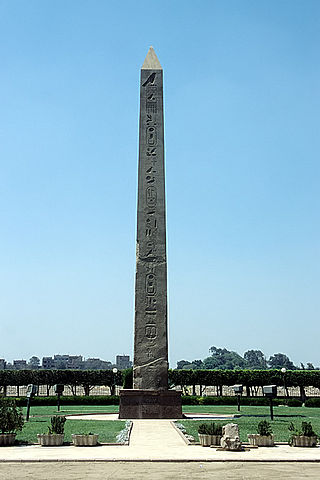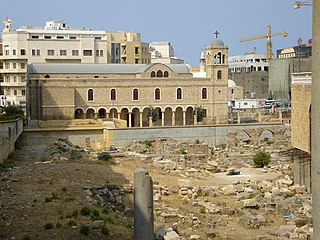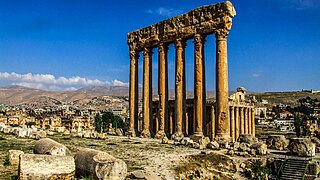Related Research Articles

Venus is a Roman goddess whose functions encompass love, beauty, desire, sex, fertility, prosperity, and victory. In Roman mythology, she was the ancestor of the Roman people through her son, Aeneas, who survived the fall of Troy and fled to Italy. Julius Caesar claimed her as his ancestor. Venus was central to many religious festivals, and was revered in Roman religion under numerous cult titles.

Baalbek is a city located east of the Litani River in Lebanon's Beqaa Valley, about 67 km (42 mi) northeast of Beirut. It is the capital of Baalbek-Hermel Governorate. In 1998, the city had a population of 82,608. Most of the population consists of Shia Muslims, followed by Sunni Muslims and Christians; in 2017, there was also a large presence of Syrian refugees.

In ancient Roman religion, the Di Penates or Penates were among the dii familiares, or household deities, invoked most often in domestic rituals. When the family had a meal, they threw a bit into the fire on the hearth for the Penates. They were thus associated with Vesta, the Lares, and the Genius of the pater familias in the "little universe" of the domus.

Heliopolis was a major city of ancient Egypt. It was the capital of the 13th or Heliopolite Nome of Lower Egypt and a major religious centre. Its site is within the boundaries of Ain Shams and El Matareya, districts (kism) in northeastern Cairo.

Berytus, briefly known as Laodicea in Phoenicia or Laodicea in Canaan from the 2nd century to 64 BCE, was the ancient city of Beirut from the Roman Republic through the Roman Empire and Early Byzantine period/late antiquity. Berytus became a Roman colonia that would be the center of Roman presence in the Eastern Mediterranean shores south of Anatolia.

The history of ancient Lebanon traces the course of events related to the geographic area in the Eastern Mediterranean of what is now known as Lebanon from the beginning of antiquity to the beginning of Arab rule.
Triparadeisos or Triparadisus was a settlement in Lebanon near the sources of the Orontes. A paradeisos was a hunting reserve or pleasure-ground for the nobility of the Achaemenid (Persian) Empire, normally a walled-in area with groves of trees, wild animals, and running water.
Jupiter was king of the gods in the ancient Roman religion. Numerous temples were dedicated to him in Rome and throughout the Roman Empire. Notable examples include:

Phoenicia under Roman rule describes the Phoenician city states ruled by Rome from 64 BCE to the Muslim conquests of the 7th century. The area around Berytus was the only Latin speaking and Romanized part of Aramaic-speaking Phoenicia.

Saturn was a god in ancient Roman religion, and a character in Roman mythology. He was described as a god of time, generation, dissolution, abundance, wealth, agriculture, periodic renewal and liberation. Saturn's mythological reign was depicted as a Golden Age of abundance and peace. After the Roman conquest of Greece, he was conflated with the Greek Titan Cronus. Saturn's consort was his sister Ops, with whom he fathered Jupiter, Neptune, Pluto, Juno, Ceres and Vesta.

The Temples of the Beqaa Valley are a number of shrines and Roman temples that are dispersed around the Beqaa Valley in Lebanon. The most important and famous are those in Roman Heliopolis. A few temples are built on former buildings of the Phoenician & Hellenistic era, but all are considered to be of Roman construction and were started to be abandoned after the fourth century with the fall of the Roman Paganism.

The Temple of Jupiter is a colossal Roman temple in Baalbek, Lebanon. It is the largest of the Roman world after the Temple of Venus and Roma in Rome. It is unknown who commissioned or designed the temple, nor exactly when it was constructed. It is most likely construction begun in the first century BC. It is situated at the western end of the Great Court of Roman Heliopolis, on a broad platform of stone raised another 7 m (23 ft) above the huge stones of the foundation, three of which are among the heaviest blocks ever used in a construction. Cultic activity had long taken place at the site; the temple presumably replaced an earlier one, possibly using the same foundation.

Qalaat Faqra is an archaeological site in Kfardebian, Lebanon, with Roman and Byzantine ruins. Located near the Faqra ski resort on the slopes of Mount Sannine at an altitude of 1500 m, it is one of the most important sites of the UNESCO-listed valley of Nahr al-Kalb.

This article lists historical events that occurred between 401–500 in modern-day Lebanon or regarding its people.

This article lists historical events that occurred between 201–300 in modern-day Lebanon or regarding its people.

This article lists historical events that occurred between 101–200 in modern-day Lebanon or regarding its people.

This article lists historical events that occurred between 1–100 in modern-day Lebanon or regarding its people.

Jupiter Optimus Maximus Heliopolitanus was a syncretic supreme god venerated in the great temple of Baalbek, in modern-day Lebanon. The cult of Jupiter Heliopolitanus evolved from the ancient Canaanite religion, particularly the worship of the storm and fertility god Baal-Hadad. Baal, meaning "lord" or "master," was a title used for various local deities, while Hadad was specifically revered as the god of rain, thunder, and storms, closely linked to agricultural fertility. Over time, the cult of Baal-Hadad in Baalbek acquired solar characteristics, possibly due to Hellenistic influences that equated Baal-Hadad with the Greek sun god Helios. This syncretism continued under Roman rule, with the deity further merging attributes with the Roman god Jupiter, culminating in the construction of a monumental temple complex dedicated to Jupiter Heliopolitanus in the second century AD. The temple was renowned for its oracular functions and served as a significant center of divination, with the cult of Heliopolitan Jupiter spreading throughout the Roman Empire.